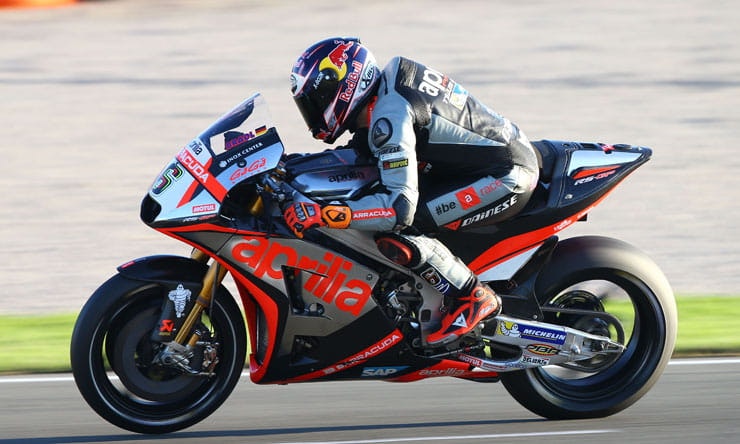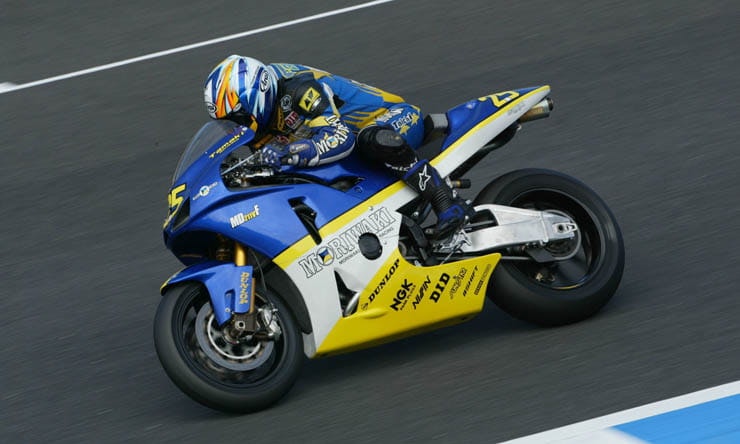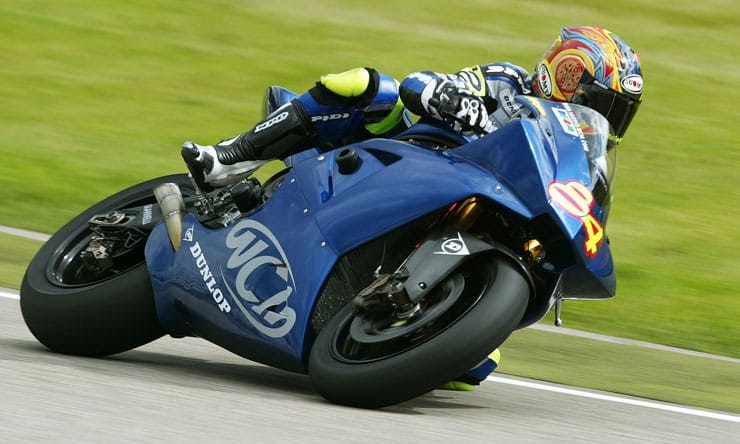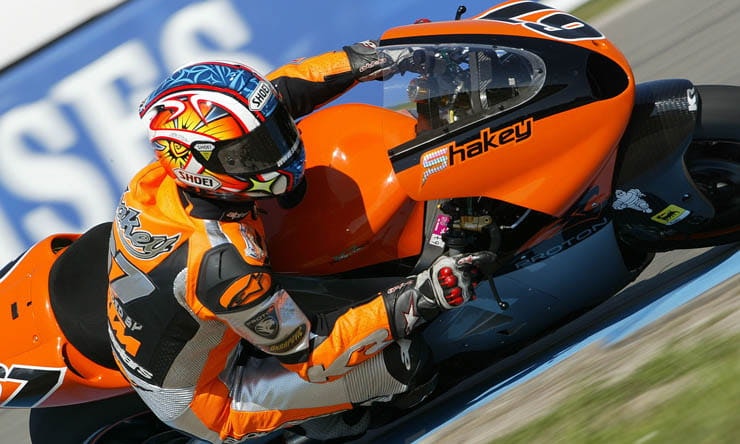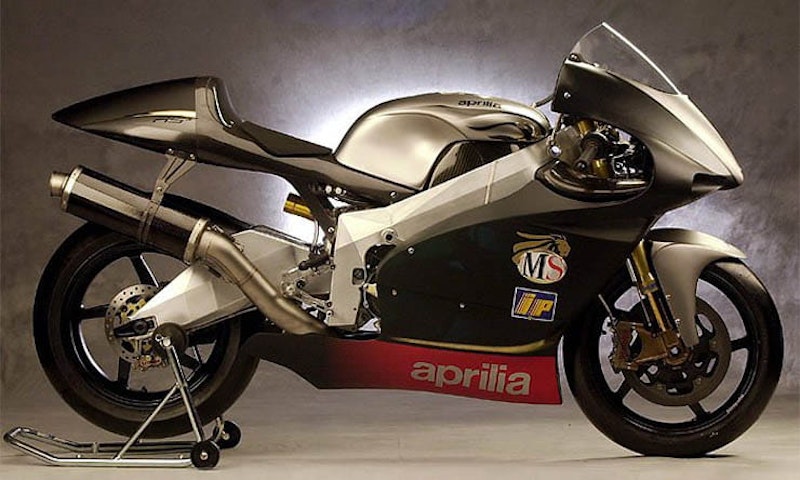It’s the final part of our series of features celebrating 15 years of the four-stroke MotoGP series. We've already looked at the efforts from Honda, Yamaha, Suzuki, Ducati and Kawasaki, and this time we’re taking a look at some of the machines that either made brief appearances in the championship, did it without major manufacturer support or are just emerging onto the scene.
While we’re not including all the road-bike-based efforts that took part in the short-lived ‘CRT’ era from 2012-2013, or the ‘Open’ 2014 bikes, here we want to cover the machines that qualified as true MotoGP prototypes but perhaps didn’t get the same attention as the front-runners or the major factories.
None of these bikes ever won a GP – few even came close to sniffing the podium – but they’re still an essential part of the four stroke era.
2003 RS Cube
While 2002’s results weren’t spectacular, many still believed in the Aprilia’s potential come 2003. Not least of those were the factory riders, Colin Edwards and Noriyuki Haga.
Like many at the time, Aprilia thought that the new generation of MotoGP machines would be better suited to riders proven in superbikes. Haga had ridden for Aprilia in world superbikes in 2002, and also had useful previous 500cc experience, and Edwards was the reigning world superbike champ. Their credentials were strong, so when Edwards described the RS Cube as ‘born bad’ few could argue with the statement. Haga crashed the bike 28 times during the season.
The fact was that the F1-derived fly-by-wire and engine electronics weren’t capable of giving the delicate control needed on two wheels.
With Aprilia focussing on the engine and electronics, the bike’s chassis wasn’t changed significantly for 2003, nor for 2004 for that matter. The aerodynamics were updated with new bodywork, though.
In terms of tech, the development of the electronics was constant through the year in the search for more control, and the bike also gained an automated clutch to allow downshifts without touching the lever.
The bikes results were fractionally improved over the previous year. Edwards was 13th in the championship, with a best finish of sixth, with Haga back in 14th and achieving no better than seventh in any race.
Aprilia
Of all the companies that haven’t reached the podium in MotoGP, Aprilia is by far the largest and the one that’s made the biggest effort.
The Italian company is no stranger to race success, both with two-strokes and in world superbikes, but it’s made two distinct stabs at MotoGP without seeing much success. Or at least not yet, as its 2017 campaign is just as serious an effort as it’s ever made before.
Let’s start with the first era, and the frankly terrifying RS Cube…
Gestation of the Aprilia RS Cube
In GP racing Aprilia’s foundation was built on two-strokes. A major player in the lower classes, it has 38 world titles in 125cc and 250cc world championships and during the 1990s it started to make inroads into the 500cc class.
In that category the firm was a pioneer in using a twin-cylinder engine, taking advantage of a reduced minimum weight (105kg vs 130kg for four-cylinder strokers) and using a bored-out version of its 250cc RSW, first at 410cc, later 460cc and eventually 500cc, to compete against the rival V4s.
Short on power, the bikes never saw the top step of the podium but shook up the establishment enough to persuade Honda to develop the twin-cylinder NSR500V just in case it turned out to be a better solution.
When the four-stroke class was announced, Aprilia took the same approach – aiming to compete in the lightest of the three weight categories that MotoGP brought. The initial rules allowed twins and triples to be 135kg, fours and fives to be 145kg and six-cylinders to be 155kg.
More cylinders means more revs and more power, so Aprilia opted for a triple. This was also because the 990cc regulations meant each cylinder would be 330cc. At the time, Formula One engines were all V10s, with capacities that had recently been reduced from 3500cc to 3000cc (so 350cc per cylinder to 300cc per cylinder). That meant there was a massive knowledge resource in how to achieve the best gas-flow and combustion in cylinders that size.
Aprilia went to Northampton-based Cosworth, a leading F1 engine designer and supplier, to help create an inline triple based on F1 tech.
Following F1 practice, the engine was developed around the ideas of pneumatic valves, high-end electronic control systems, traction control and a fly-by-wire throttle – the sort of thing that’s normal today, but unheard of on bikes at the time.
2002 RS Cube
A lone bike, ridden by Regis Laconi, was entered for the inaugural MotoGP championship. It looked spectacular – sharp angles on the frame and swingarm, which gave it something of a stealth fighter look, contrasted with sweeping, smooth bodywork.
The engine, with fly-by-wire throttles and a distinctive rasp from its three cylinder layout, made the most of its F1 heritage and was widely believed to be the most powerful on the grid. Top speeds were often on a par with the top Hondas, particularly on tracks where power made a big difference, but the bike quickly developed a reputation for being hard to handle.
Although Laconi opened the season with an eighth place finish in the wet at Japan, albeit a lap down, but it was a position he’d never improve on during the year. The latter half of the season saw more retirements than finishes, and his final position – 19th – wasn’t really representative of either his talent or the bike’s potential.
2004 RS Cube
Both of 2003’s riders, battered and bruised, looked for employment elsewhere and Aprilia turned to their former 250 and 500 rider Jeremy McWilliams, who’d had two years four-stroke running on the Roberts Proton GP bike in 2002 and 2003. His team mate was fellow Brit, British superbike champion Shane Byrne.
Aprilia claimed there were 235 new parts on the bike at the start of the season, although the revamped bodywork was the most visible of these. The frame and swingarm designs remained much as before, and – as it turned out – the engine’s character wasn’t much better either. Worse, the power advantage that Aprilia had held in the opening MotoGP seasons had been eroded. Although still powerful – estimates put the Cube at between 225bhp and 250bhp – it was a mid-field machine in top speed terms in 2004. Jockey-like McWilliams generally achieved significantly higher speeds than the bigger Byrne thanks to his smaller stature and weight.
By the end of the year, with its riders in 19th and 20th in the championship and Byrne missing several rounds due to Aprilia-induced injuries, the Cube hadn’t come close to troubling the top 10. Aprilia ditched the MotoGP project, despite having already developed a largely new triple for the 2005 season. It had hit financial problems and in 2004 was bought out by Piaggio, leading to a rethink of all its future plans.
Aprilia stayed away from MotoGP for the best part of a decade.
Gestation of the RS-GP
The creation of the CRT (claiming rules teams) class came in 2012 to help bolster a flagging MotoGP grid, along with the rules changing the capacity limit from 800cc (2007-2011) to 1000cc.
In a 180-degree U-turn from its original ‘prototypes only’ regulations, CRT allowed the use of production-based engines – slashing costs by letting teams run 1000cc motors honed in the Superbike World Championship, but in custom-made frames.
It was under the CRT regulations, as ART (Aprilia Racing Technology) that Aprilia returned to MotoGP. It supplied the Aspar, PBM and Speed Master squads with bikes derived from its successful world superbike RSV4 superbike.
The bike would compete for three years – 2012, 2013 and 2014 – before Aprilia re-entered MotoGP with a development of the idea, reworked to full MotoGP spec, raced by the Gresini team and named RS-GP.
2015 Aprilia RS-GP
Where the ART CRT bike used a tuned RSV4 road bike engine, bolted to a frame that was unique but closely followed the design of the RSV4 as well, the near-identical-looking RS-GP was developed to compete under full MotoGP regulations.
Most importantly, the V4 engine is new. Its layout might be similar to the RSV4’s but it uses pneumatic valves to help it rev higher and make more power – believed to be in the region of 250bhp.
The frame and swingarm of the 2015 bike were developments of its ART predecessor’s, and as such kept noticeable similarities to the RSV4 road bike.
The teams two riders, Bautista and Melandri, didn’t trouble the top half of the field. Melandri left halfway through the year, never finishing better than 18th, to be replaced by Michael Laverty and then Stefan Bradl, who had similar results. Bautista did better, with a lone 10th place finish and 16th overall in the championship.
2016 Aprilia RS-GP
If 2015’s bike had been a reworked version of the previous CRT machine, that isn’t an accusation to be levelled at the 2016 version. A new frame, swingarm and bodywork set it aside as a real MotoGP bike once again.
The engine was new, too, with a narrower V-angle to allow better weight distribution. Power was claimed to be over 250bhp. Although Aprilia ended the season behind rivals Honda, Yamaha, Ducati and Suzuki, the step forward was noticeable.
Bautista, sticking with the project, finished the championship 12th, with a best finish of seventh. Bradl was 16th overall, but also managed a solitary seventh place finish.
For 2017 the bike has been upgraded once again, with big changes to the engine, while the rider pairing is all-new – with Aleix Espargaro and Sam Lowes taking the helm.
Effects on road bike development
While it’s hard to see direct hand-me-down effects from the ill-fated RS Cube project, while that bike was current the firm made no bones of the fact it wanted to build a three-cylinder production model to mimic its design, probably as a sub-RSV, 600-class machine. In an era before Triumph’s Daytona 675 or MV Agusta’s F3, it might have made for an interesting bike. But the problems with the Cube, plus Aprilia’s financial woes and its 2004 takeover by Piaggio, meant it would never happen.
The latest MotoGP project has its roots in a production bike, the RSV4, rather than the other way around. However, since its introduction Aprilia has become the first bike firm to offer pneumatic valves on a customer bike – the track-only RSV4 FW-GP uses the technology – and the company has its eye on creating road bikes with the same concept in the future.
Valiant attempts, freaks and oddballs
While Aprilia is the last of the major motorcycle manufacturers in this series of features – we haven’t included KTM’s effort here as its new bike has only raced once prior to the start of the 2017 season – there have been plenty of smaller, independent efforts to get onto the grid.
Here are the most noteworthy of them.
Proton Team KR
Kenny Roberts’ had already been running a GP team at the top level since 1986 and became a constructor in 1997, making the three-cylinder KR3, initially under the Modenas name and later as Proton with investment from the Malaysian car brand.
The 2002 four-stroke rules posed a problem. During that transition year the team was still allowed to run its old two-stroke, but it needed to go four-stroke for 2003. Without the backing of a major bike firm, Roberts needed to come up with his own four-stroke machine.
2003 Proton KR5
Honda had stolen a march on the competition in 2002. The V5-powered RC211V was dominant and its weird layout was one of the reasons for its success – five cylinders gave a power advantage while still squeezing into the same weight limit class as four-cylinder machines.
Seemingly undaunted by the technical complexity of making a five-cylinder engine, Proton set out to create its own V5 for 2003. And, against all odds, they did it.
Legendary F1 designer John Barnard helped put the project together. Not ready at the start of the year, riders Jeremy McWilliams and Nobuatso Aoki started the year on the old two-stroke, but got the KR5 in time for round four in Italy.
Unfortunately, the bike went to show that simply having the same design concept as Honda wasn’t a guarantee of success. It was underpowered and slow – both riders’ best results of the year actually came on the old three-cylinder two-stroke!
2004 Proton KR5
The 2004 KR5 didn’t do much better than before. The aerodynamics were updated, as was the chassis and swingarm, but the results were still poor.
Kurtis Roberts retired from six of eight races before being replaced by Brit James Haydon, who didn’t fare much better but achieved the team’s best finish of 12th. Aoki remained, but couldn’t better 13th.
2005 Proton KR KTM
You thought KTM’s entry to MotoGP at the end of 2016 was a first? Nope, the Austrian firm intended to enter the series right from its conception in 2002. KTM developed an engine and was in the midst of developing a chassis when plans changed and the project was dropped in mid-2003.
It could have remained one of those might-have-been MotoGP machines, but following its disastrous V5 engine, Proton Team KR persuaded KTM to supply the engine for its own bike in 2005.
Visually, the bike still looked much like the 2004 machine, but the KTM engine was a 75 degree V4 with pneumatic valves, arranged radially. KTM quoted 230bhp at 15,500rpm.
Shane Byrne was brought in to ride the bike, but only managed a solitary championship point with 15th at Laguna Seca. Shortly afterwards, KTM withdrew the engine supply, citing contractual problems with Proton Team KR, leaving the team with no engine for the remainder of the season.
2006 KR211V
Given the struggles of the previous years, there didn’t seem to be much hope for the KR squad until the team miraculously secured a supply of Honda RC211V V5 engines for 2006.
Despite having a customer version of arguably the best engine on the grid, few expected the underfunded team to have much success. The bike’s chassis and bodywork were still largely unchanged, after all, so why expect a transformation?
In fact, the Honda engine went to show that the Proton frame was actually rather good – its development team, Fabrication Techniques, went on to be better known as chassis suppliers FTR in later years.
With Kenny Roberts Jr on board, the bike was suddenly a front-runner. After a slow start to the season, results improved, with third places in Catalunya and Portugal. As a manufacturer, they beat Kawasaki and came close to matching Suzuki, gaining fifth in the constructors’ championship.
2007 KR212V
The 2007 800cc rules meant that the success of the KR211V was limited to a single season. Honda’s agreed to supply engines again for 2007, with the new V4 motor from the RC212V, but is different configuration meant that the Roberts chassis and aerodynamics changed significantly compared to the design the team had been honing before. The new Honda engine wasn’t that great either.
Kenny Jr stayed aboard, but results weren’t close to the previous year. He left the team mid-season, replaced by brother Kurtis Roberts, who’s luck wasn’t much better. A best finish of 12th and an overall points haul of just 14 (compared to 134 the previous year) were to be the last we saw of the plucky KR effort.
Moriwaki MD211VF
Among the stranger bikes to have reached the grid in MotoGP was the Moriwaki MD211VF that appeared just nine times over three years in 2003, 2004 and 2005.
Japanese tuning and race firm Moriwaki’s project hung on its rare ability to lease an RC211V V5 engine from Honda. The company built a steel trellis frame around it and called the bike the Moriwaki Dream Fighter, or MD211VF.
The project appeared twice in 2003, at five races in 2004 and twice more in 2005. In total, it managed eight championship points and a best finish of 11th before becoming a footnote in MotoGP history.
Harris WCM
The WCM (World Championship Motorsports) team ran in 500s using Yamaha-powered ROC frames from 1992-1996 and factory-spec Yamahas from 1997 to 2002. But for 2003, with two-strokes being phased out entirely, the firm had to become a manufacturer, creating its own four-stroke machine.
To cut development costs, the engine was developed from the existing Yamaha YZF-R1 production bike motor, with most of the parts replaced using race-spec components.
The bike looked good – in part thanks to a lack of sponsors – but after failing to race in the season opener in Japan it was banned before the second round in South Africa. The engine fell foul of rules intended to ensure all bikes were prototypes; it was too closely related to the R1.
Riders Chris Burns and David de Gea sat out the first half of the season while the bike was redesigned, coming back mid-year, initially on a mismatched pair of ROC Yamaha machines before finally getting an approved version of the four-stroke for the last six rounds. It was barely worth it, proving to be little more than a mobile chicane with a best finish of 19th.
The following year the bike was developed and, with Michael Fabrizio and Chris Burns aboard, actually managed to score points on a few occasions, getting a best finish of 10th. And in 2005 WCM was back again, rebranded with the name of Czech minibike firm Blata. The plan had been to use a brand new V6, which never appeared, leaving the same old four cylinder to race on. James Ellison and Franco Battaini scored 13 points between them. That was the end for WCM’s MotoGP effort, though.
Ilmor X3
Rarely has a project promised so much and disappeared so quickly as the Ilmor X3.
Developed by Mario Illien, F1 engine designed extraordinaire, at his firm’s base in Brixworth, Northamptonshire, it was a state-of-the-art V4 with pneumatic valves and every other F1-style trick. Mounted in a Suter-designed chassis, the resulting bike looked spectacularly good and was ready by the end of the 2006 season.
Running as a wildcard entry in the last two rounds of the 2006 season the Ilmor was the first 800cc bike to compete – the rest of the field was still running 990cc machines. Ridden by Garry McCoy, it impressed by both finishing and scoring in both races, albeit in 15th place.
That performance set high hopes for 2007, when the rest of the field would also be running 800cc bikes.
While Ilmor started the 2007 season full of plans, even scheduling a second-generation bike to appear mid-season, the team raced only once. Neither Jeremy McWilliams nor Andrew Pitt, its 2007 riders, finished the season opener in Qatar, and shortly afterwards Ilmor announced the end of the project. A lack of sponsorship was blamed.
The project didn’t die completely, though – the Ilmor engine lived on as a high-revving testbed, while the Suter chassis and similar bodywork was later fitted with a 500cc V4 two-stroke. Shown under the Paton brand in 2009, as the ‘Gran Premio 500’ it emerged again under Suter’s own name as the STR500 in 2012 before morphing into the super-expensive, track-only Suter MMX500 that you can buy today.
